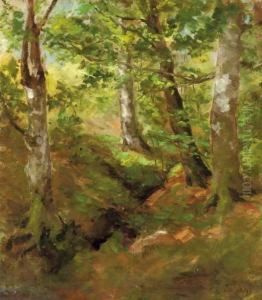Antonovna Lagoda-Shishkina Ol'Ga Paintings
Olga Antonovna Lagoda-Shishkina, commonly known as Olga Shishkina, was a Russian painter who lived during a period of significant social and artistic change. Born on May 22, 1861, in the town of Prudy, near Moscow, she was part of the movement that transitioned from 19th-century academic art to the more diverse and experimental styles of the 20th century.
Shishkina received her education in art from the Moscow School of Painting, Sculpture and Architecture, which was one of the largest and most progressive art institutions in Russia at the time. She was a contemporary to many other influential Russian artists and was likely to have been influenced by the Peredvizhniki (Wanderers) movement, a group advocating for social realism and the accessibility of art to the public outside the confines of the imperial academies.
Throughout her career, Shishkina's work was marked by a focus on landscapes and domestic scenes, capturing the simple beauty of Russian life and nature. Her style was characterized by a realistic approach, and she was known for her ability to convey light and atmosphere in her depictions of the Russian countryside.
Despite the social upheavals of the Russian Revolution in 1917 and the subsequent changes in the country's artistic landscape, Shishkina managed to continue her work. During the Soviet era, the state controlled the arts through official organizations such as the Union of Soviet Artists, which enforced the Socialist Realist style. Although Shishkina's work was not overtly political, the emphasis on the realistic depiction of everyday life in her earlier work aligned with some of the principles of Socialist Realism.
Olga Shishkina lived through both World Wars and the interwar period, which were times of great hardship in Russia. She witnessed the transformation of Russian society from the rule of the Tsars, through the revolutionary period, to the establishment of the Soviet Union. Despite the challenges of these times, she continued to paint and contribute to the Russian art scene until her death on July 28, 1945, in Moscow.
Shishkina's legacy is that of a dedicated artist who captured the essence of Russian life and landscape during a time of great change. Her works remain as a testament to her skill and as a reflection of the society in which she lived. As with many artists of her time, her contributions to Russian art history provide insight into the culture and aesthetics of a bygone era.
